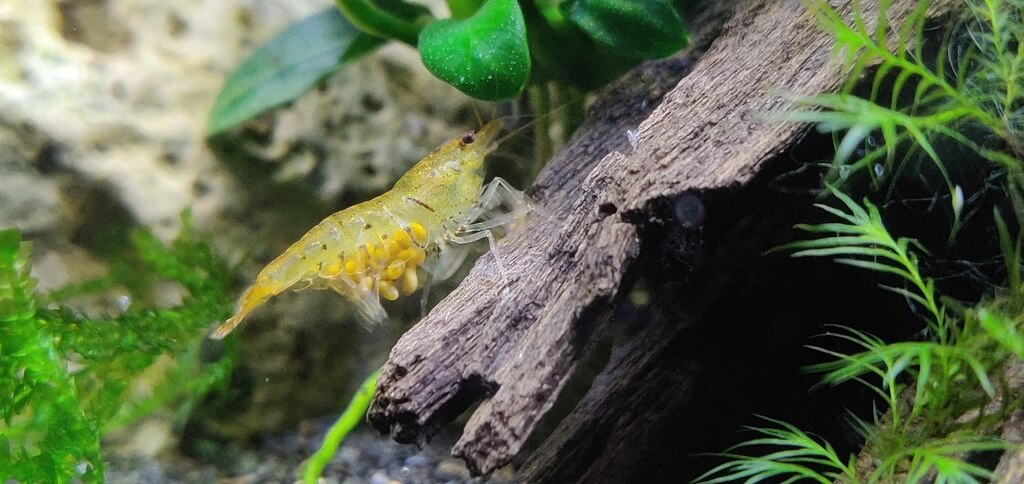Most shrimp keepers are excited to try and start breeding a healthy colony in their new tanks.
However, sometimes the shrimp need some time to settle in, or they aren’t totally happy with the tank setup.
This article will explain everything you need to know and offer some tips to try and get your shrimp breeding soon.
When do shrimp breed?
Cherry and Bee shrimp reach sexual maturity at around 4 to 6 months old. This is roughly when they reach their adult size of 2 to 3 cm.
New shrimp added to a tank will likely take at least a few weeks to settle in before any breeding begins. The change in water parameters and layout of the tank will stress them slightly whilst they adjust to their new surroundings.
You should expect this adjustment period to last roughly 4 to 6 weeks, assuming all the water parameters are in the preferred ranges.
Breeding behaviour
The breeding behaviour starts with a saddled female shrimp.
A saddle is a yellow-green spot on a shrimp’s back, just behind their head, that holds unfertilized eggs. This can be quite hard to see in some stronger coloured morphs, like a high grade Red Cherry.
When a saddled female molts, she will also release a pheromone into the water, attracting males to come and mate with her. After molting, shrimp are vulnerable until they’ve grown their new exoskeleton, so usually hide for a while.
As soon as the males detect this pheromone, they’ll get excited and start swimming laps around the tank in search of the female.
Once a male finds the saddled female, she might run away and hide again if she’s unsure about this partner. If she’s happy with the choice, they will mate.
The eggs are then fertilized and move from the saddle to down under her body, in her pleopods or swimmerets. A female shrimp carrying eggs is called a berried shrimp, simply because the eggs look like tiny berries.
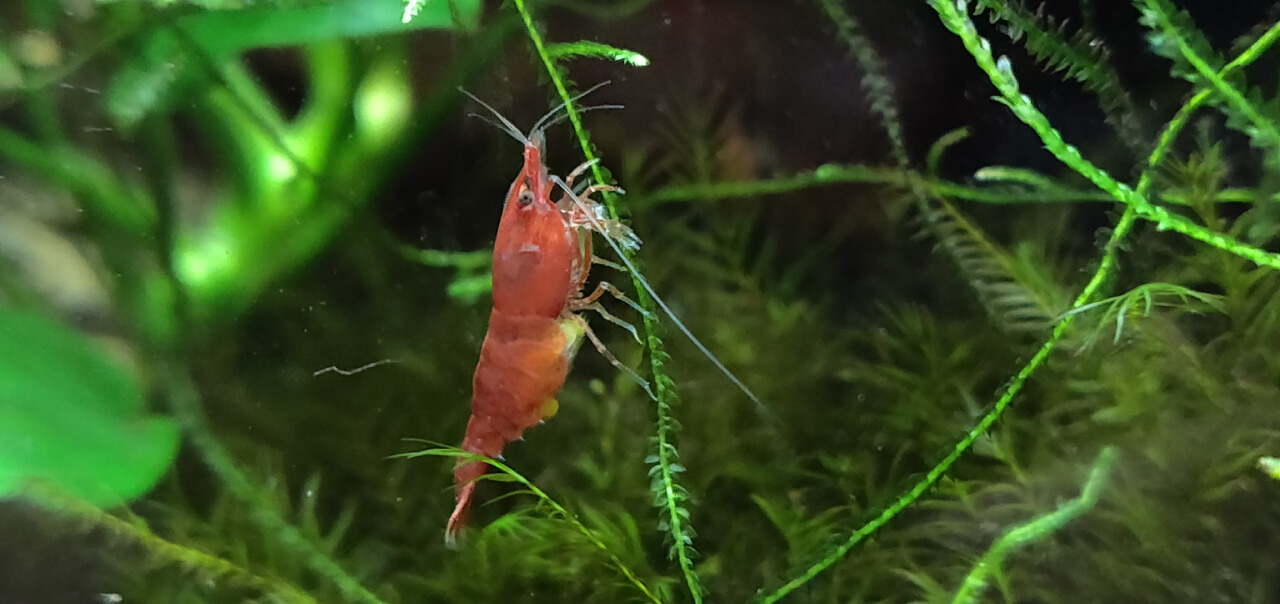
How many babies do cherry shrimp have?
Neocaridina and Caridina shrimp will typically have between 20 and 30 babies at a time. With plenty of biofilm and algae, the vast majority should make it safely to adulthood.
How long do they carry the eggs?
The female will carry the eggs for around 3 to 4 weeks until they hatch.
Whilst the female is carrying the eggs, she will frequently fan them using her pleopods. This keeps them clean and oxygenated until they’re ready to hatch.
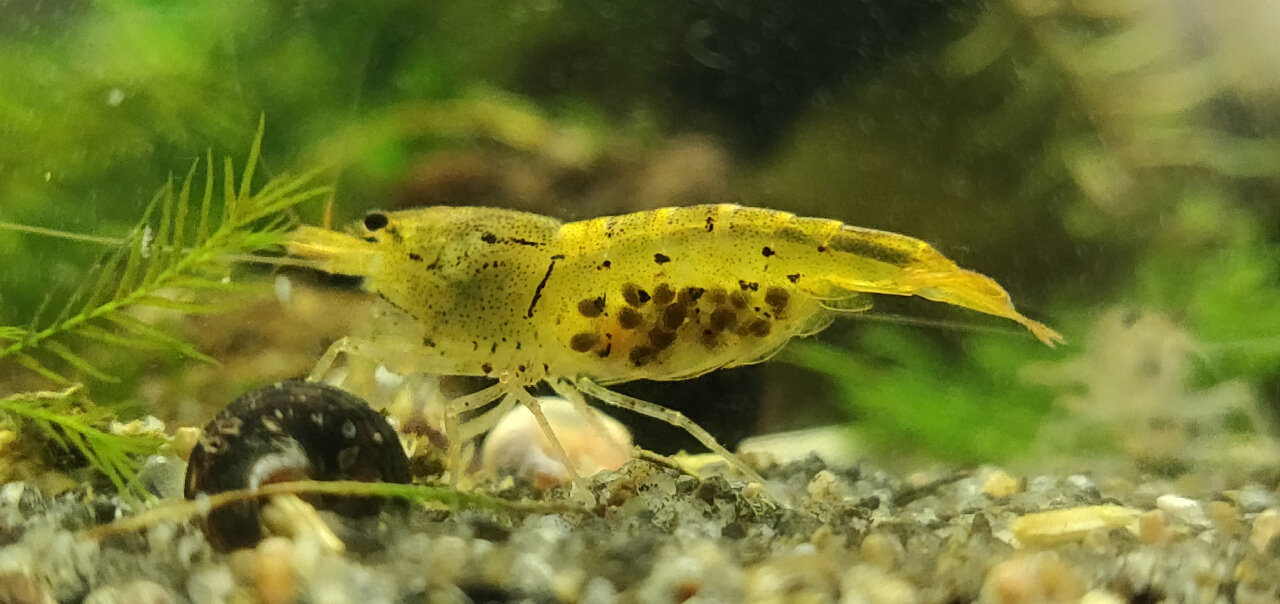
Water changes
It’s a common misconception that changing the water frequently will trigger molting and speed up breeding.
You should perform water changes to a consistent schedule, such as 20% every two weeks.
Doing water changes too often, or changing too much at once, can stress your shrimp. If the new water parameters aren’t an exact match to the current water, it could potentially lead to some shrimp getting stuck in a molt, for example.
Tips to encourage breeding
These tips will hopefully help you to get your shrimp population growing soon.
Warmer water
Shrimp will typically breed more readily in slightly warmer water, around 23 °C.
This is why you’ll normally notice a lot more babies in the tank during the summer compared to the winter months.
If you’re trying to encourage breeding year round, then you could consider using a heater during the cooler seasons.
Healthy water parameters
You’ll get much more success with keeping shrimp in their ideal water parameters. Keeping Caridina shrimp in water above 7 pH, for example, will cause them to breed very slowly, if at all.
Check the core parameters to make sure they’re in the healthy ranges for their species.
Molting problems can occur if the water’s too hard or too soft. Ensuring the females can molt safely is a very important early step for breeding.
You should also check that there isn’t any ammonia or nitrites measurable in the water. These elements are toxic to your shrimp and will affect their health.
Increase female ratio
Are you sure you’ve got a sensible ratio of males to females? Try to identify the sex of your shrimp to see if you have around 50% females.
An ideal breeding setup would likely have a 20:80 male:female ratio. This will allow them to quickly build up a huge population.
The simple logic here is that females can only release their eggs about once a month. Adding more females allows for breeding to occur more often, giving you more baby shrimp sooner.
Lots of food
The adults will feel much more comfortable breeding if they know there’s plenty of food around for a larger colony. You should check that you’re feeding your tank enough to keep them happy.
Baby shrimp will also normally hide in a small section of the tank after hatching, barely moving for their first few weeks. This is why it’s so important to have a mature tank with lots of biofilm and algae to eat to increase the baby shrimp’s chance of survival.
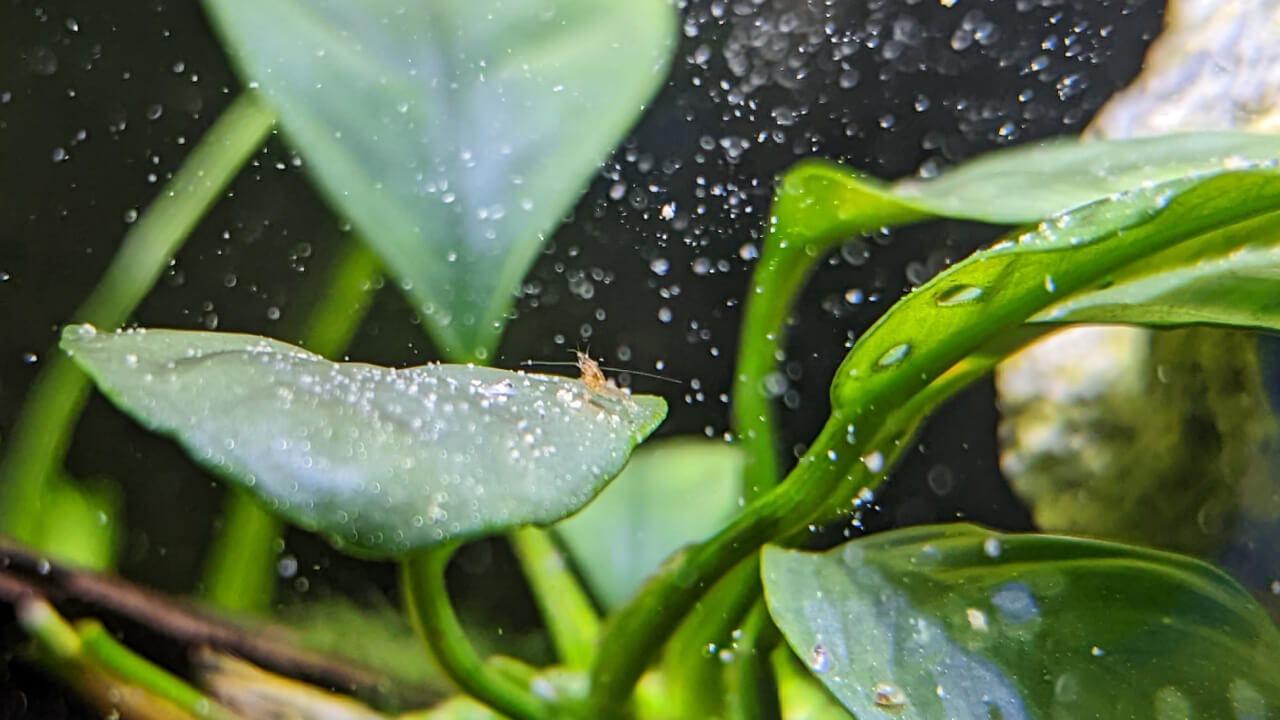
Some suggestions for baby food are bacteria supplements like Bacter AE or Shrimp King BioTase Active. These will encourage biofilm growth, and make up the majority of their diet.
Alternatively, snowflake pellets and leaf litter make great foods for baby shrimp too. They can be left in the tank without polluting the water over time, giving plenty of time for the babies to find it. As these foods are also fairly large and spread out, the babies don’t have to worry about getting pushed away by hungry adults either.
Use a safe filter
Baby shrimp are incredibly small when they first hatch, so it’s important to make sure your filter is shrimp safe. Otherwise, the babies could get sucked into the filter, and be trapped or injured.
A shrimp safe filter is simply one that has a fine mesh or sponge on any intake pipes. The sponge should be very fine, not like a loose wire mesh.
If you’ve got an all-in-one tank with a built-in filter, you can put a very fine mesh just behind the intake holes.
Tank size
Along with using a safe filter, you should make sure your growing colony has enough room.
A 10 gallon tank is probably the most common choice for breeding dwarf shrimp, but you can use any size you like. The larger volume of water will help keep the tank’s parameters stable and prevent stressing the shrimp.
The bigger aquariums will give you a lot more room for plants, and give you more freedom with the hardscape.
Try to make use of the space in the tank with driftwood and rocks to give them areas for biofilm to grow, as well as places to hide.
Make hiding spots
It’s very important to give your shrimp plenty of hiding places in their tank.
After they’ve molted, they’ll feel vulnerable for a while and want somewhere to hide and feel safe. If they feel stressed and in danger, they won’t be in the mood for mating.
After molting, female shrimp will massively appreciate being able to hide quickly to get away from the males.
Mosses and plants can provide some great options for hiding spots. Baby shrimp specifically will love hiding amongst the moss and eating any algae and biofilm in it. Java moss specifically is a fantastic choice because of how quickly and widespread it grows.
Adding floating plants to your tank will give your shrimp plenty of space to hide among the roots. These roots will also collect a lot of the detritus floating around, ready to be eaten as a snack.
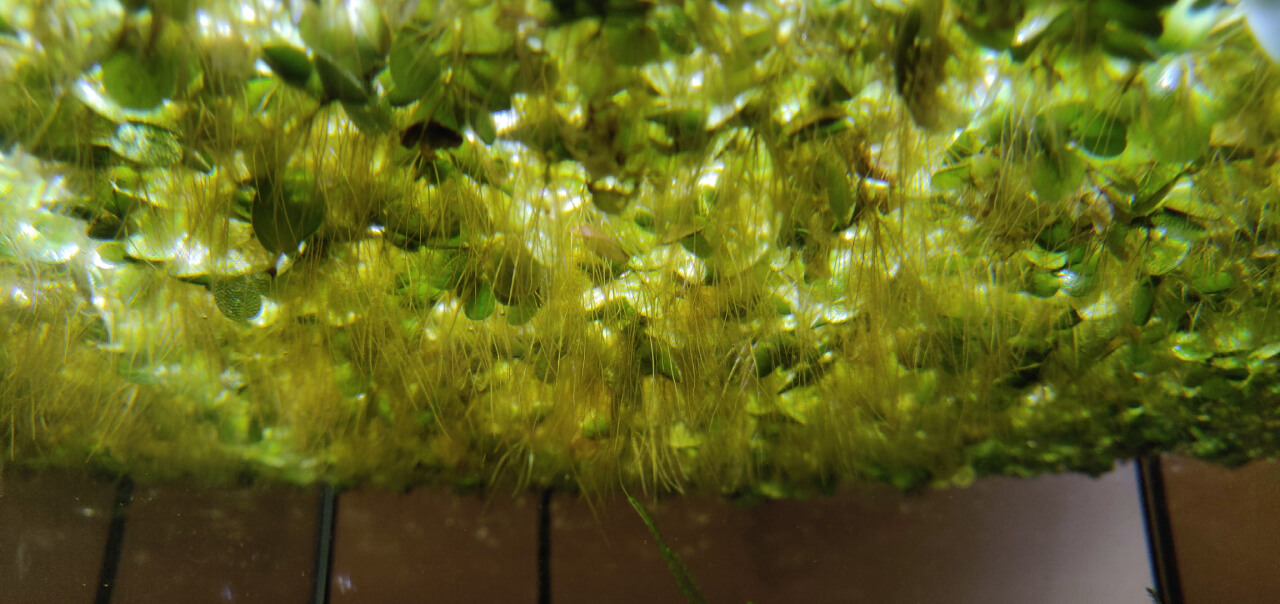
Rocks and driftwood caves are also great for similar reasons. The hardscape can also provide shelter to the shrimp if you’ve got strong water flow from your filter.
Having no good hiding spots can stress shrimp, and sometimes lead to berried females dropping their eggs.
Dropped eggs
Unfortunately, some shrimp mothers can drop a few of their eggs.
Sometimes this is because they’re stressed and are focussed on escaping or surviving as a priority. If you notice this happening often, test your water parameters and try to find what may be stressing them.
It’s also fairly common for first-time berried shrimp to lose some, or all, of their eggs. This is believed to be down to lack of experience and should reduce over time.
It’s possible for dropped eggs to hatch, so don’t panic if you see any. Some shrimp keepers have built their own DIY egg tumbler to improve their chances of success.

